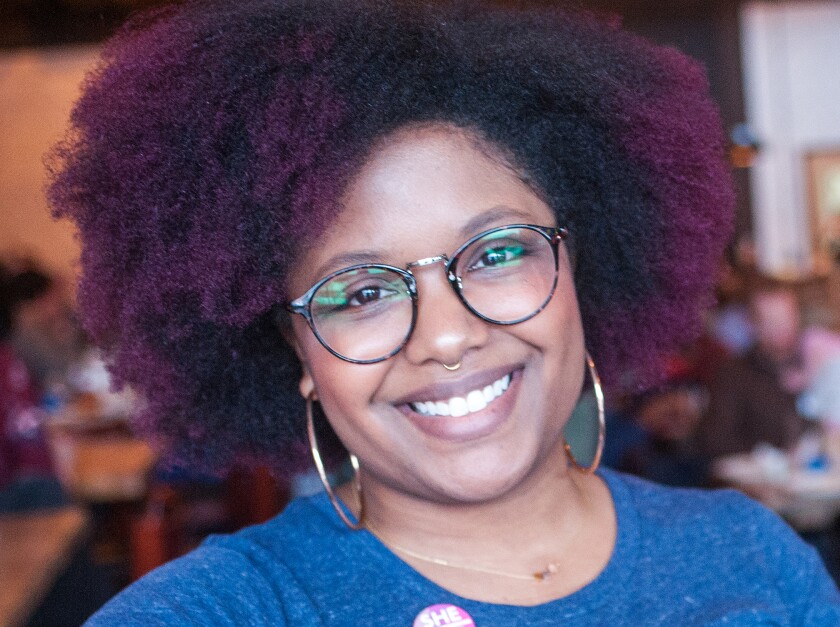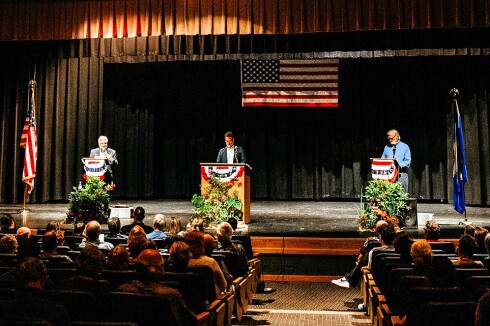This was supposed to be a story about community silence in the decades following the 1920 lynching deaths in Duluth of Elias Clayton, Elmer Jackson and Isaac McGhie.
But there was always at least one group for which the lynchings were never silenced.
ADVERTISEMENT
The African American community never succumbed to the amnesia that followed Duluth’s worst day: 100 years ago Monday.
“Lynching is an act of terror to bring fear to the black community,” said Terresa Moses, University of Minnesota Duluth assistant professor and Duluth NAACP officer.

“It was hidden for years,” Duluth activist and community elder Henry Banks said. “(But) if you were African American, if you were tied to the university here as a student, I can guarantee you, you knew about it. Because our African heritage elders were protecting us, so that we didn’t get caught up in anything like that.”
Portia Johnson echoed Banks from her East Hillside lawn last week.
“Let’s remember — for centuries, black people and Africans’ stories were told orally,” Johnson said to a backdrop of wind chimes. “That’s how I learned.”
ADVERTISEMENT
Johnson came to Duluth in 1966 as a wife in an Air Force family. She would join others at the house of the late Bill Maupins, a UMD staffer who would host salon-style discussions in his kitchen and organize supply drives for the civil rights movement in the 1960s.
“Bill would tell us about the lynchings and talk about it,” Johnson said. “Here in Duluth, it was from person to person.”

By the turn of the century, the topic of the lynchings had been revived in full by Michael Fedo’s narrative non-fiction, the print journalism of Heidi Bakk-Hansen in the former Ripsaw, and annual gestures by ardent people determined to memorialize the men.
But until then, the collective citywide memory within the white community of what happened had all but evaporated.
This, despite families being able to trace their heritage just one or two generations back to people who made up the murderous mob.
ADVERTISEMENT
“I talked to people and said, ‘Do you know what happened here back in 1920?’” former mayor Gary Doty said. “And I explained it to them and most people in Duluth didn’t know that.”

Overcoming opposition from businesses and residents worried about tainting the city’s reputation, Doty, as mayor, helped lead the effort to create the Clayton Jackson McGhie Memorial in 2003 at the corner of East First Street and North Second Avenue East.
By then, the story for the city’s African American community was as old as time.
And while the intervening years of silence may have afforded the white community a respite from its shame, the African American community remained subjected to the whims and aggressions of their predominantly white neighbors.
Black people who remained, that is.
ADVERTISEMENT
A black population in Duluth of 495 in 1920 had dwindled to 314 by 1950. Sources cite the lynchings and other economic injustices with conspiring to produce what has been referred to as Duluth's black exodus. Two important documents from the era of white silence help to illustrate how African Americans lived in the city during those times.
“The Negro Population in Duluth, Minnesota 1950” is the result of UMD research into 69 black families by sociologist and university educator and administrator Gus Turbeville. The other document, from 1986, “Black Students and Programs at the University of Minnesota-Duluth: The Need for Change,” was written by Catherine Maddox-Wiley as her master’s thesis.
Each document is laced with examples of discrimination and injustice.
From Turbeville came testimony that:
Real estate companies wouldn’t show places east of Eighth Avenue.
Black customers were made to wait and given lesser cuts of meat at the butcher’s.
Skilled labor, such as bricklaying, was denied to blacks, who populated factories as "unskilled labor."
There were no black doctors or dentists in town.
Blacks had trouble getting store credit afforded to white customers.
Blacks faced hostility in schools, including one boy not allowed to join a robed choir.
Prospective black teachers at local universities were not allowed to do their student teaching in Duluth.
One black man said he was denied a job because there was no segregated bathroom; others quit the railroad because they weren't allowed in the union.
One large group of whites was refused service at a fancy restaurant for having a black woman in their group.
Disapproval for interracial romantic attractions.
Whites characterized black people as “clannish,” and “too aggressive in their expectations.”
Such claims followed into Maddox-Wiley’s work, as she wrote “(A)ssertiveness in a Black person is always viewed as aggressiveness.” Among the scores of observations she makes about UMD in the 1980s across nine chapters:
Black students being made to “assimilate” to white culture and adopt the “prestige dialect.”
No black faculty or administration, and under-representation of black staff and advisers, who were overloaded with all work and expectations related to the minority race.
Lack of trusted academic counseling and heavy course loads for black students, including overlap of the most difficult classes, resulting in failing work.
A “shameful” dragging of its heels by UMD administration when it came to black-aimed recommendations.
No minority scholarships, and a siphoning of financial aid available to black students; in 1985-86, only $6,300 out of $60,000 budgeted made it to black students.
Failure by administration to attend black-led programming, and annual threats to cut it.
Failure by instructors to allow black students to choose their topics, disregarding topics such as apartheid in South Africa as “too controversial,” with one instructor being vulgarly dismissive of Martin Luther King Jr.
In eight years of study, only 16 black students graduated from UMD. In 1986, there were 20 black students among 7,500 overall.
Recruitment efforts were either misleading about the wealth of black experience, or dismissive of blacks altogether.
In one instance, a group of black students from the Minneapolis Upward Bound program toured campus in the summer of 1985. No admissions materials were handed out or counselors made available.
“The Black student adviser was not even contacted,” Maddox-Wiley wrote.
ADVERTISEMENT
In another tragic line, she wrote: “The students stay away from anyone black, as if Blacks are a disease.”
Such is the sort of detail that brings out the anger in Johnson, who spoke as pinwheels whirred in her yard.
“There is still lynching going on and how they’re doing it is in education,” Johnson said, referring to well-documented achievement gaps between whites and minorities in Duluth schools and statewide. “We’ve gone downhill.”
A longtime member of the Duluth Public Schools’ then-desegregation board, Johnson still laments the dissolution of Duluth Central High School — once the city’s most diverse school and where the 79-year-old’s four children attended.
Johnson also noted there is no regular Clayton Jackson McGhie curriculum in local public schools.
“They won’t allow it,” Johnson said.
Superintendent Bill Gronseth addressed the claim, saying a curriculum is taught in one of the high school grade levels, and that the district is working on wider implementation.
ADVERTISEMENT
When Moses arrived to Duluth earlier this decade, she was met with the lynchings' oral history, too.

“They sat me down and let me know as a person of color, 'Here are the things to look out for — not only do we have a legacy of lynchings, but here is how it shows up in microaggressions,’” Moses said.
There are lots of similar hand-me-down conversations in black lives, including the ones when Johnson told her children what to do when encountering police. The same Duluth police who followed her home for a month straight after she bought a brand-new red Jeep in 1992. Police once stopped her to ask how she could afford it. When she'd devise different routes home from work as a early childhood education instructor for St. Louis County, police would sometimes be parked on the street waiting for her.
"I'm a drug dealer," she said. "That’s what I was, according to them, because no black in this town can afford a fancy new Jeep."
Johnson always taught her children to pick the right moments to defend themselves.
One time, in 1966, just weeks after moving to Duluth, Johnson endured an encounter she said will stick with her forever.
She and three of her children were walking east on downtown Superior Street when a well-dressed businessman, not unlike all those in the Clayton Jackson McGhie lynching postcards, patted the heads of all the children.
“That is a no-no, but a lot of white folks used to do that,” Johnson said. “The slave owners did that to little kids. Of course, our hair is altogether different from white people’s. That man did that to my kids. You just don’t do that. My kids were little when that man did that. All I could do was turn around and stick my tongue out at him.”
She did it in protest. The children wondered why and required an explanation. But the man never saw it.
Reporters Samantha Erkkila and Christa Lawler contributed to this story.








